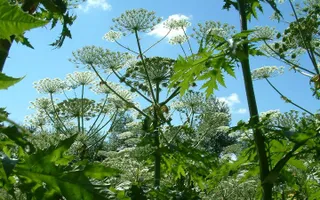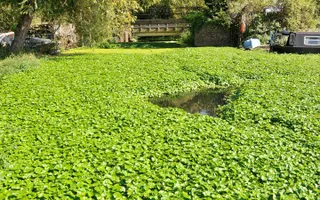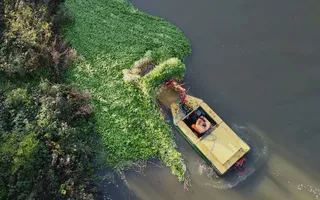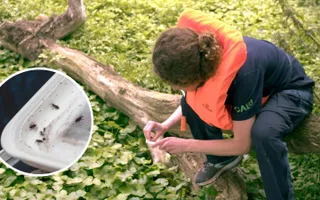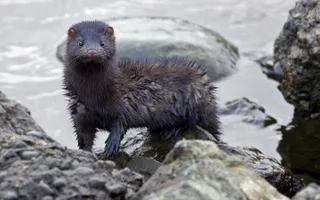So, here we are on the River Weaver in Cheshire. And we’re here to talk about invasive non-native species and how we can all prevent them spreading through a process called ‘check, clean, dry’.
So on the river, we have a real big problem with floating pennywort. And at the moment, the river’s clear. But in summer in late summer, it can completely cover the waterway.
More than 50 non-native species have accidentally been introduced into our canals, rivers, and lakes from all over the world. And numbers are rising rapidly. They can cause major damage. They outcompete native wildlife, damage ecosystems, and spread disease. They can also block canals, causing a thick, green carpet, which restricts navigation, clogs up propellers, and damages boats.
The Canal & River Trust is a charity, and every year, it costs us hundreds of thousands of pounds to clear unwanted vegetation and manage the delicate ecosystems which exist in many of our waterways.
So, what harmful plants and animals do we need to watch out for? So, we’re talking about things like Japanese knotweed and giant hogweed, but also things that you might not see, freshwater shrimp or zebra and quagga mussels. Quagga mussels have even been found in an isolated angling reservoir in Lincolnshire. The nearest other known place with quagga mussels is London, which is over 140 miles away. So, how did this species travel overland for such a long distance? It probably hitchhiked on a person, on their equipment, tools, or machinery. Some species can survive for days, even up to a week, in a damp environment.
So, how can people help? One of the most important things everyone can do is to stop the spread of harmful plants and animals to a new area. There are three simple steps to remember: check, clean, dry. This should be done before you leave a waterway, even if you’re only moving to another spot on the same waterway but a few miles away.
The first step is to check any clothing, tools, or equipment have come into contact with the water – or even mud around the water. If you find any plant fragments or animals, remove them and leave them at the site. Ideally, bin them, but always make sure that they can’t get back into the water.
The second step is to clean your clothing, tools, or equipment, ideally with hot water, but real good rinse with cold water will also dislodge bits of plants and young animals that you cannot see. Use a bottle of fresh water if you have one, or wash things down with a hose. Try and do it on a surface where the water can drain into the ground.
The last step is to dry everything completely, ideally in the sun, leaving no damp patches.
Don’t forget about clothes as well, things like wetsuits, waders on boots. Small invertebrates can live for days in damp folds and clothing, and seeds can get stuck in the tread of muddy boots.
We’re here to talk about invasive species. Where would you check on your boat for invasive species?
The most obvious places would be the weed hatch, the front and back fenders, mooring lines front and back and centre, anything that’s going to be touching the water, so boat poles, any cans or dippers that you might be using, anything that’s really making contact with the water. If you get anything around the propeller, then obviously you go into the weed hatch, and you have to get your arm in there and clear it. The most important thing then would obviously be to try and remove that, whatever you get. If it’s something like pennywort or something like that, to try and remove it from the canal.
So, how regularly would you check and clean your boat?
Okay, so if you’re going on a long journey, I would say that you need to do it at the start of the journey, and as frequently as possible really, preferably once a day. If you’re going from one waterway to another, then I would say so definitely do it. If you’re going from a river to a canal, then you might be transferring things from a river that don’t belong on a canal and vice versa, really. Things will dry off quite naturally in the open air, and there’s plenty of it out here really. But anything that you can dry off, you could do it like a car really with like a chamois leather or things like that, or you could think about having like a fresh set of ropes in a locker so every couple of days you could swap and change your ropes over after you’ve cleaned and dried them.
So, where would weed or invasive species get caught on your boat, and how do you go about checking and cleaning it?
We’ll get it caught in various places, like the riggers, the fin, the bowel ball at the bottom. If you capsize, you may get it in here as well. Going about cleaning it, would get a hot water and some sponge, give it a once over and try and get rid of every last bit of dirt.
Where does weed or invasive species tend to get caught on a paddleboard?
Well, Tom, they get caught in the very front on the valve seating, and as we come down to the board, you can see it gets caught in the luggage bungee cords here, and then, of course, as you come down to the footplate, you can see it gets embedded into the non-slip surface of the spot plate. And again, on the leash, you can see on the velcro on the leash, it really does capture it, you know, so it needs to be cleaned thoroughly and as we go further down onto the leash onto the D-ring it gets caught there. And, of course, if you turn the board over, you can see the fin at the back, it tends to get captured into the fin as well and the securing nook. And then finally, on your paddle. You get spores on the paddle as well, so of course, when you take it home, you must ensure you wash it clean with fully cold water. And any weed that you collect from your board is disposed of in a nearby bin or left on the land but not put back in the water.
So, where is most important to check for invasive species in all your equipment?
Okay, well, if you’re a canal angler, you’re on the towpath, actually, your box and equipment on the towpath isn’t actually as high risk. It’s the stuff that’s in the water where you need to check first, so you’ve got your landing nets, which you check looking for if anything that hits the ride and also if you’re a match angler and some pleasure anglers use these too, these are called keep nets, and this is where you put your catch in, and at the end of the session, you can see what you’ve caught. So, taking a keep net out, we will do, just as before, we’ll do a quick check to make sure there’s nothing in there. We shall tip it out. And look at there, straight away, we’ve got some plants that have sneaked in.
So, we’ve all got a role to play to prevent invasive non-native species from spreading around. Remember the three simple steps of check, clean, dry – especially when you’re going to different waterways. Please help us to help the waterways we all love to stay special.




